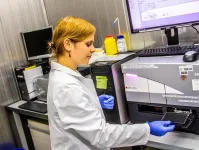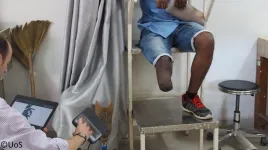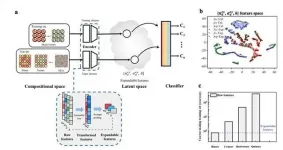(Press-News.org) The health of women aged 65 and over appears to be related, in addition to their own socioeconomic characteristics, with that of their partners, as a result of traditional gender norms. This is one of the main conclusions of research led by Jordi Gumà, a researcher at the UPF Department of Political and Social Sciences, conducted in conjunction with Jeroen Spijker, a Ramon y Cajal I3 researcher at the Centre for Demographic Studies of the Autonomous University of Barcelona (CED-UAB), focusing on the case of Spain.
The study, published in Gaceta Sanitaria, analyses the health differences among the Spanish population aged between 65 and 81 years living in couples.
According to Jordi Gumà, a member of the UPF Sociodemography Research Group (DEMOSOC), this situation is aggravated by several causes: "The fact that they often act as caregivers for their spouse (husband), has a double impact on women's health as a result of gender inequality: because they are economically dependent on their partners; and for having to assume a greater daily burden as caregivers", he explains.
The study, recently published in its final printed version in the journal Gaceta Sanitaria, analyses the health differences among the Spanish population aged between 65 and 81 years living in couples, considering the socioeconomic characteristics of the two members individually and combined. It is a pioneering approach with respect to the research carried out to date, which has so far focused on individual analysis.
The general aim of the study was to determine whether in addition to the individual's level of education, a standard indicator in this type of research, the characteristics of their partner (level of education and health status) and of the household in general (economic capacity and spousal age gap) affect the health of people aged 65 or over living with a partner.
The health status of the other member of the couple, a decisive factor
The study shows that living with a partner who is not in good health is associated with almost double the likelihood of being in the same situation, and that women's health is significantly better if their level of education is higher than their partner's, and this result is less significant in the case of men.
"According to our results, living with an older husband whose health is delicate penalizes women's health".
"The health status of the other member of the couple is the variable displaying the greatest effect on the health of the Spanish population aged 65 and over living under this model of cohabitation, although women's health seems to be more sensitive to the educational level of their partner and the general economic situation of the household", the authors assert.
In this sense, the research finds a clear gender component: "According to our results, living with an older husband whose health is delicate penalizes women's health. Conversely, the additional workload is lower for husbands when their wife's health is poor because men tend to share this burden with other, mainly female family members, particularly daughters or daughters-in-law", they point out.
Moreover, the study demonstrates the existence of an assortative mating effect, as two individuals with similar behaviour are more likely to match up, irrespective of socioeconomic status. This selective mating (partner resemblance) at younger ages, can have a cumulative effect on health over the years as a result of behavioural factors such as smoking, diet, alcohol consumption, etc.
The peculiar case of Spain, with very traditional gender roles
The study focused on analysing the case of Spain, based on a sample of nearly 1,800 people taken from the European Union Statistics on Income and Living Conditions (EU-SILC) survey (2015 wave) on the elderly (65 to 81 years) living with a partner. Based on separate logistic regression models for men and women, the authors obtained the estimate of the likelihood of not having good self-perceived health.
In Spain, the educational expansion and the massive insertion of women into the labour market started later than in other Western European countries.
They assure that they chose Spain as a case study because until now, research on joint (partner and own) education profiles and health status have focused on the United States or northern, western and central European countries, but no country from southern Europe had yet been analysed.
In addition, according to the authors, Spain is an especially interesting case because the educational expansion and the massive insertion of women into the labour market started later than in other Western European countries. Accordingly, "the productive and reproductive roles in Spain are still very much gendered for the older cohorts studied here, whereby the female socioeconomic status is almost totally determined by their partner's status", they state.
Research that may help steer healthcare policies
In the authors' opinion, one relevant contribution by their study to public policy is that "not only typical vulnerable groups like single-person, single-parent or low-income households should be targeted, but also retired low-educated partnered individuals, even if their partner is more highly educated". Moreover, "the results of the study are particularly relevant for health professionals who are in daily contact with patients as health inequalities are larger at the household level than at the individual level", they conclude.
INFORMATION:
Jordi Gumà, with the collaboration of Jeroen Spijker, is the principal investigator of the project "Prevention is better than cure when ageing is behind the door: interplay between social determinants of health in Spain" (INTERSOC-HEALTH) (2019-2022) co-funded by the Spanish Ministry of Science, Innovation and Universities (R&D&I projects, "Challenges" category) and ERDF funds, and is part of the international project "Care, Retirement & Wellbeing of Older People Across Different Welfare Regimes" (CREW).
Reference article: Gumà, J., Spijker, J. (March 2021). Are partner's features important to understand health at older ages? The Spanish case. Gaceta Sanitaria (volume 35, no. 2, pp.193-198)
https://doi.org/10.1016/j.gaceta.2019.07.005
An international team of scientists from the University of Turku, Finland and PennState University, USA have solved a long-standing mystery of how living organisms distinguish RNA and DNA building blocks during gene expression paving the way for the design of new antiviral drugs. The new insights were published in the journal Nature Communications.
All cellular organisms use two types of nucleic acids, RNA and DNA to store, propagate and utilize their genetic information. The synthesis of DNA is carried out by enzymes called DNA polymerases and is needed to accurately transfer the genetic information from generation to generation. ...
Our immune system is very successful when it comes to warding off viruses and bacteria. It also recognizes cancer cells as potential enemies and fights them. However, cancer cells have developed strategies to evade surveillance by the immune system and to prevent immune response.
In recent years, fighting cancer with the help of the immune system has entered into clinical practice and gained increasing importance as a therapeutical approach. Current therapies apply so-called immune checkpoint inhibitors. Immune checkpoints are located on the surface ...
A single-celled alga undergoes genome surgery to remove non-essential parts. This can lead to a most efficient cellular factory for producing sustainable biofuels from sunlight and carbon dioxide.
Researchers from the Qingdao Institute of BioEnergy and Bioprocess Technology (QIBEBT) of the Chinese Academy of Sciences (CAS) have stripped hundred-kilobase genome from a type of oil-producing microalgae, knocking out genes non-essential for it to function. By doing so, they have created a "genome scalpel" that can trim microalgal genomes rapidly and creatively.
The 'minimal genome' microalgae produced is potentially useful as a model organism for further study of the molecular and biological function of every gene, or as a 'chassis' strain for synthetic biologists to augment for customized ...
RALEIGH, N.C. -- Methane hydrate, an ice-like material made of compressed natural gas, burns when lit and can be found in some regions of the seafloor and in Arctic permafrost.
Thought to be the world's largest source of natural gas, methane hydrate is a potential fuel source, and if it "melts" and methane gas is released into the atmosphere, it is a potent greenhouse gas. For these reasons, knowing where methane hydrate might be located, and how much is likely there, is important.
A team of researchers from Sandia National Laboratories and the U.S. Naval Research Laboratory have developed a new system to model the likelihood of finding methane ...
Cutting-edge 3D scanners have been put to the test by researchers from the University of Southampton and partners Exceed Worldwide to help increase the quality and quantity of prosthetics services around the world.
The study, carried out within the END ...
A team of scientists led by Dietmar Krautwurst from the Leibniz Institute for Food Systems Biology at the Technical University of Munich has now identified address codes in odorant receptor proteins for the first time. Similar to zip codes, the codes ensure that the sensor proteins are targeted from inside the cell to the cell surface, where they begin their work as odorant detectors. The new findings could contribute to the development of novel test systems with which the odorant profiles of foods can be analyzed in a high-throughput process and thus could be better controlled.
The ...
Alchemy, which attempted to turn cheap metals such as lead and copper into gold, has not yet succeeded. However, with the development of alloys in which two or three auxiliary elements are mixed with the best elements of the times, modern alchemy can produce high-tech metal materials with high strength, such as high entropy alloys. Now, together with artificial intelligence, the era of predicting the crystal structure of high-tech materials has arrived without requiring repetitive experiments.
A joint research team of Professor Ji Hoon Shim and Dr. Taewon Jin (first author, currently at KAIST) of POSTECH's Department of Chemistry, and Professor Jaesik Park of POSTECH Graduate School of Artificial Intelligence have together developed a system that predicts ...
TROY, N.Y. -- Numeric anchoring is a long-established technique of marketing communication. Once a price is mentioned, that number serves as the basis for -- or "anchors" -- all future discussions and decisions. But new research shows that this phenomenon is not limited to decisions that involve numbers, the use and understanding of which require high-level cognitive thinking. Anchoring also biases judgments at relatively low levels of cognition when no numbers are involved.
In research recently published in the Journal of Behavioral Decision Making, Gaurav Jain, an assistant professor in the Lally School of Management at Rensselaer Polytechnic Institute, demonstrated that anchoring even occurs in perceptual domains, ...
Chemists all over the world are constantly searching for simple ways to make elemental nitrogen or N2 in the air available for chemical reactions. This is no easy task, as nitrogen is a particularly non-reactive gas with a triple bond, which is one of the strongest known chemical bonds. A research team at Friedrich-Alexander-Universität Erlangen-Nürnberg (FAU) has now demonstrated that calcium, a metal commonly found in nature, is able to break the highly-stable nitrogen bond and can do so at minus 60°C. This is significant for two reasons. On the one hand, the researchers at FAU have made a new discovery in terms of the bond-breaking capabilities of calcium, which had been largely disregarded in the past. On ...
The snow may be melting, but it is leaving pollution behind in the form of micro- and nano-plastics according to a McGill study that was recently published in Environmental Pollution. The pollution is largely due to the relatively soluble plastics found in antifreeze products (polyethylene glycols) that can become airborne and picked up by the snow.
The researchers used a new technique that they have developed to analyze snow samples collected in April 2019 in Montreal for both micro- and nano-sized particles of various plastics. The McGill technique is orders of magnitude more sensitive than any of the other current methods used for tracing plastic in the environment. It ...





